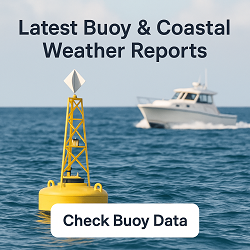Pensacola, FL Weather Forecast and Current Conditions
Current Conditions From Nearby Local Station

Feels Like 49°F
at
Point Forecast at a Glance







7-Day Temperature Trend
Week Ahead Summary
High temperatures remain relatively stable through the week, ranging from 63°F to 72°F. Some rain possible with at least 2 days showing precipitation chances of 20% or higher.
Climate Context
This week's forecast shows temperatures running 4°F above the historical average for December. Normal highs for this period are around 64°F with lows around 43°F.
This Date in Weather History
1941 - Only two women were employed by the Weather Bureau. By 1945, more than 900 women are employed by the Weather Bureau as observers and forecasters, as a result of filling positions of men during World War II. Eleven days after Pearl Harbor, the Army requested that all weather broadcasts be discontinued. The fear was that the enemy would use this information to plan an attack on the United States.
Pensacola, FL 7 Day Weather Forecast Details
Tuesday Dec 16

Night: Mostly cloudy, with a low around 49. Northeast wind around 5 mph.
Wednesday Dec 17

Day: A 20 percent chance of showers after 3pm. Mostly cloudy, with a high near 65. East wind 5 to 10 mph.

Night: A 50 percent chance of showers. Cloudy, with a low around 58. East wind around 5 mph. New precipitation amounts of less than a tenth of an inch possible.
Thursday Dec 18

Day: Showers, with thunderstorms also possible after 9am. High near 68. Southeast wind 5 to 10 mph becoming south in the afternoon. Chance of precipitation is 80%.

Night: A 50 percent chance of showers, mainly before midnight. Partly cloudy, with a low around 50. South wind 5 to 10 mph becoming north after midnight.
Friday Dec 19

Day: Sunny, with a high near 63. North wind 5 to 10 mph.

Night: Mostly clear, with a low around 43. North wind around 5 mph becoming east after midnight.
Saturday Dec 20

Day: Sunny, with a high near 68. East wind 5 to 10 mph becoming southeast in the afternoon.

Night: Partly cloudy, with a low around 57. South wind around 5 mph.
Sunday Dec 21

Day: Mostly sunny, with a high near 72.

Night: Partly cloudy, with a low around 57.
Monday Dec 22

Day: Mostly sunny, with a high near 71.

Night: Partly cloudy, with a low around 55.
Tuesday Dec 23

Day: Mostly sunny, with a high near 69.
About Pensacola, FL
Content from Wikipedia, licensed under CC BY-SA 3.0.
How We Provide Better Local Weather
Current conditions: We use the nearest available station to your location - including professional MESONET/MADIS and local weather stations - often miles closer than regional airports.
Forecasts: National Weather Service point forecasts predict for your specific area, not broad regional zones, making them far more relevant to your location.



